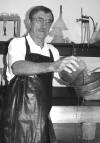Howard Ferris Biography
Revised:
01/01/2020
Howard Ferris was born in Rochdale, England. Following WWII,
his family migrated to southern Africa, living first in Capetown, South Africa
and then in Gweru, Zimbabwe (then Southern Rhodesia). His high school education
was at Chaplin School in Gweru and, for two years, at Christchurch Boys’ High
School in
 Christchurch, New Zealand. After graduating high school he was invited
to work for the summer at the Tobacco Research Board of Zimbabwe, as a
short-list candidate for an academic scholarship. At that institution he was
assigned to the Nematology Department under the mentorship of Dr. R.A.C. Daulton.
Daulton assigned Ferris two tasks that summer:
Christchurch, New Zealand. After graduating high school he was invited
to work for the summer at the Tobacco Research Board of Zimbabwe, as a
short-list candidate for an academic scholarship. At that institution he was
assigned to the Nematology Department under the mentorship of Dr. R.A.C. Daulton.
Daulton assigned Ferris two tasks that summer:
- To read and inwardly digest the first three chapters of J. R. Christie’s
book "Plant Nematodes, Their Bionomics and Control" (Daulton told Ferris "If
you read that material you will have a solid grasp of the current status of
Nematology");
- To collect and propagate the common weed species growing on the research
station (there were about 18) and to determine their host status to
Meloidogyne javanica.
The scholarship was awarded and Ferris studied botany and zoology at the
University College of Rhodesia and Nyasaland, a college of the University of
London. A proviso of the scholarship award was the requirement to work each
summer in the Nematology Department at the research institute and for a further
three years following graduation. After graduation, Ferris was sent to the
Agricultural University in Wageningen, Netherlands to attend a "total immersion"
course in all aspects of Nematology. There he studied with Oostenbrink, Hijink,
Loof, s'Jacob, Seinhorst and several other prominent Nematologists. After
returning from that course he started research on a MSc project in Zimbabwe as
an external student of the University of London.
Those were politically unsettled times in Zimbabwe and Ferris was drafted
into the army in the middle of the MSc program. A requirement for completion of
the MSc degree was thesis defense before a committee chaired by Dr. Nigel Hague
on the parent campus in England. While in England in 1968, he received news that
his position at the Tobacco Research Board in Zimbabwe had been terminated as a
result of downscaling in response to international economic sanctions on the
tobacco industry. He contacted Daulton, who by then was working for the Dow
Chemical Company in Zurich, Switzerland and was offered a position with Dow
Europe. Unsure whether that option met his career goals, Ferris returned to
Zimbabwe where colleagues with contacts at North Carolina State University
recommended him for graduate study with Dr. C.J. Nusbaum in the Department of
Plant Pathology. He began studying for the Ph.D. degree in September 1968. Among
his responsibilities at NC State University, Ferris worked with Nusbaum’s
technician, DeWitt Byrd, Jr., processing soil samples and assessing nematode
populations in field plots conducted by Dr. Furney A. Todd in his Extension
Research-on-Wheels program. Working with Byrd, and following his admonition that
"remember Howard, there’s always a quicker, easier and more efficient way to do
things" led to their development of the automated elutriator.
After completion of the Ph.D. program, Ferris was offered two positions; one
at the International Potato Center in Lima Peru, the other in the Department of
Nematology at UC Riverside. He accepted the latter and was appointed Acting
Assistant Nematologist on July 1, 1972.
Ferris’s academic career at UC Riverside was influenced by then department
chair S.D. Van Gundy who guided him from the research series appointment to a
professorial appointment as Assistant Professor of Nematology and Assistant
Nematologist. Teaching responsibilities included taking over Nematology 216,
Advanced Plant Nematology, from Dr. Ivan Thomason. He was also involved in the
development and steering of the Master’s degree program in Pest Management and
taught the modeling course for that program.
At the statewide level, Ferris served on the committee that designed the
University of California’s Integrated Pest Management Project. He served as a
member of the Technical Committee of the project for many years and as Associate
Director of the project in the early 1980s. In 1984, the position of Chair of
the UC Davis Division of Nematology was advertised, and Ferris applied. He
accepted the position after assurance by Dean Charles E. Hess that the unit would
be supported in growth and resource development. Ferris moved to Davis in May
1985. The Division of Nematology evolved into the Department of Nematology
and, following administrative reorganizations, merged into the Department of
Entomology and Nematology in 2012.
Go to Nemaplex Home Page
 Christchurch, New Zealand. After graduating high school he was invited
to work for the summer at the Tobacco Research Board of Zimbabwe, as a
short-list candidate for an academic scholarship. At that institution he was
assigned to the Nematology Department under the mentorship of Dr. R.A.C. Daulton.
Daulton assigned Ferris two tasks that summer:
Christchurch, New Zealand. After graduating high school he was invited
to work for the summer at the Tobacco Research Board of Zimbabwe, as a
short-list candidate for an academic scholarship. At that institution he was
assigned to the Nematology Department under the mentorship of Dr. R.A.C. Daulton.
Daulton assigned Ferris two tasks that summer: